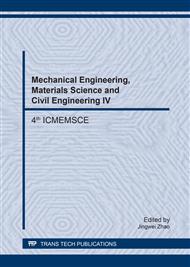[1]
K. Nakane, K. Mizobe, E. C. Santos and K. Kida, The Betti number of prior austenite structure of repeated quenching bearing steels (JIS, SUJ2), Applied Mechanics and Materials, Vol. 307, pp.409-414. (2013).
DOI: 10.4028/www.scientific.net/amr.1082.191
Google Scholar
[2]
K. Nakane, K. Mizobe, E. C. Santos and K. Kida, The Quantization of the structure of fisheyes via homology method, Applied Mechanics and Materials, Vol. 372, pp.273-276. (2013).
DOI: 10.4028/www.scientific.net/amm.307.409
Google Scholar
[3]
K. Nakane, K. Kida, T. Honda, K. Mizobe and E. C. Santos, Influence of repeated quenching on bearing steel martensitic structure investigated by homology, Applied Mechanics and Materials, Vol. 372, pp.270-272. (2013).
DOI: 10.4028/www.scientific.net/amm.372.270
Google Scholar
[4]
K. Nakane, K. Kida and K. Mizobe, Homoogy analysis of austenite grain size of SAE52100 bearing steel processed by cyclic heat treatment, Applied Mechanics and Materials, Vol. 813, pp.116-119. (2013).
DOI: 10.4028/www.scientific.net/amr.813.116
Google Scholar
[5]
K. Nakane, E. C. Santos, T. Honda, K. Mizobe and K. Kida, Homology analysis of structure of high carbon bearing steel: effect of repeated quenching on prior austenite grain size, Materials Research Innovations, Vol. 18 (Supplement 1), pp.33-37. (2014).
DOI: 10.1179/1432891713z.000000000353
Google Scholar
[6]
K. Nakane, Y. Tsuchihashi and N. Matsuura, A simple mathematical model utilizing topological invariants for automatic detection of tumor areas in digital tissue images, Diagn Pathol. Vol. 8 (Suppl 1), S27. (2013).
DOI: 10.1186/1746-1596-8-s1-s27
Google Scholar
[7]
K. Kida, K. Mizobe, R. Arai and K. Nakane, The Betti number of prior austenite grain of repeated quenching bearing steels (JIS, SUJ2), Advanced Materials Research, Vol. 1082, pp.191-196. (2015).
DOI: 10.4028/www.scientific.net/amr.1082.191
Google Scholar
[8]
M. Ishida, K. Kida, K. Mizobe and K. Nakane, The Betti number of fatigue fracture surfaces of low carbon steel (JIS, S45C), Advanced Materials Research, Vol. 1102, pp.59-63. (2015).
DOI: 10.4028/www.scientific.net/amr.1102.59
Google Scholar
[9]
J. E. Srawley, Wide range stress intensity factor expressions for ASTM E 399 standard fracture toughness specimens, Int. Jour. of Fracture, 12 (1976).
DOI: 10.1007/bf00032844
Google Scholar
[10]
J. C. Newman, Jr., Stress Analysis of the Compact Specimen Including the Effects of Pin Loading, Fracture Analysis, ASTM STP 560, American Society for Testing and Materials, pp.105-121. (2013).
DOI: 10.1520/stp33136s
Google Scholar


